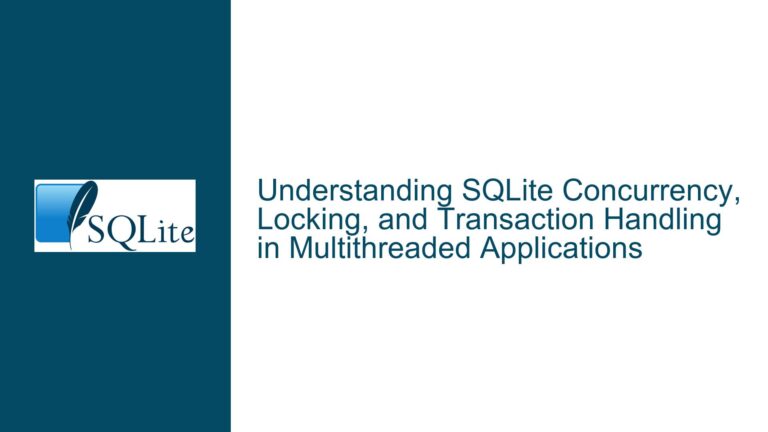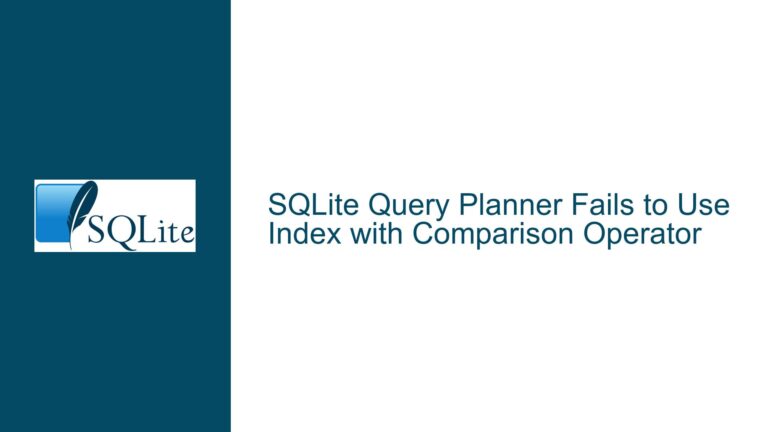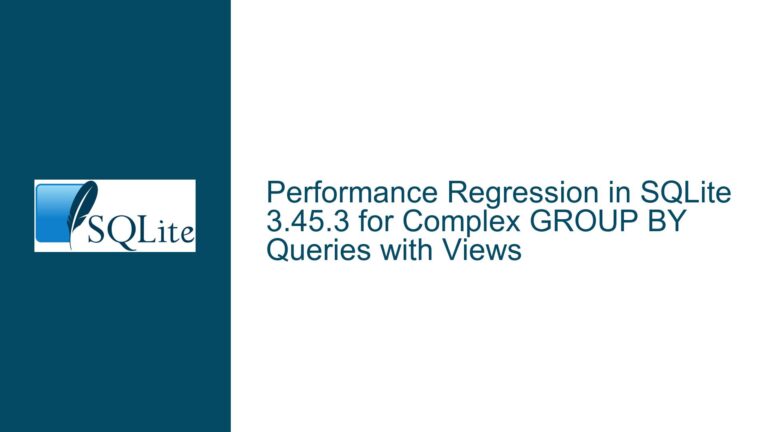and Resolving High Real Time in SQLite Queries Due to Index Usage and IO Bottlenecks
Issue Overview: High Real Time in SQLite Queries Despite Low CPU Usage
When executing SQLite queries, particularly those involving joins and filtering on multiple columns, users often observe a significant discrepancy between the real time (elapsed time) and the sum of user and sys times (CPU time). This discrepancy can be particularly pronounced when the query involves filtering on multiple columns of a table, where only one index is used per table, leading to inefficient data retrieval and high IO overhead.
For example, consider a query that joins two tables, images and treatments, and filters on multiple columns of the treatments table. The query might look like this:
SELECT Count(DISTINCT images."id") AS num_of_records
FROM images
JOIN treatments ON images.treatments_id = treatments.id
WHERE treatments."status" = 'sp. nov.'
AND treatments."checkinTime" >= ((julianday('2024-01-01') - 2440587.5) * 86400000);
In this case, the query plan might show that only one index is being used for the treatments table, leading to a high real time compared to the user and sys times. This is often due to the fact that SQLite can only use one index per table in a query, and the query planner may not always choose the most efficient index for the given filters.
Possible Causes: Index Selection and IO Bottlenecks
The primary cause of the high real time in such queries is the inefficient use of indexes, which leads to excessive IO operations. SQLite’s query planner typically selects one index per table to use in a query, and this choice may not always be optimal, especially when filtering on multiple columns. When the query planner chooses an index that does not effectively narrow down the result set, the database engine ends up reading many more rows than necessary, leading to increased IO operations.
For instance, in the query above, the query planner might choose to use the index on the status column, which has a low cardinality (i.e., there are only a few distinct values for status). This means that the index does not effectively narrow down the result set, and the database engine has to read a large number of rows from the treatments table, only to discard most of them when applying the checkinTime filter. This results in a high real time, as the database engine spends a significant amount of time waiting for data to be read from disk.
Additionally, the use of temporary B-trees for operations like COUNT(DISTINCT) can further exacerbate the problem, as these operations require additional IO and memory resources. The query planner’s decision to use a temporary B-tree for counting distinct values can lead to increased IO overhead, especially when the result set is large.
Troubleshooting Steps, Solutions & Fixes: Optimizing Index Usage and Reducing IO Overhead
To address the issue of high real time in SQLite queries, it is essential to optimize index usage and reduce IO overhead. Here are several strategies that can help achieve this:
1. Use Compound Indexes for Multiple Filters
One way to improve query performance is to create compound indexes that cover multiple columns used in the query’s filters. For example, if you frequently filter on both status and checkinTime, you could create a compound index on these columns:
CREATE INDEX idx_treatments_status_checkinTime ON treatments(status, checkinTime);
This index allows the query planner to efficiently narrow down the result set based on both columns, reducing the number of rows that need to be read from disk. However, this approach may not be feasible if there are many possible combinations of filters, as it would require creating a large number of compound indexes.
2. Use Common Table Expressions (CTEs) with INTERSECT
Another effective strategy is to break down the query into smaller parts using Common Table Expressions (CTEs) and combine the results using the INTERSECT operator. This approach allows the query planner to use multiple indexes for the same table, as each CTE can use a different index. For example:
WITH
one(id) AS (SELECT id FROM treatments WHERE status = 'sp. nov.'),
two(id) AS (SELECT id FROM treatments WHERE checkinTime >= ((julianday('2024-01-01') - 2440587.5) * 86400000)),
cmp(id) AS (SELECT id FROM one INTERSECT SELECT id FROM two)
SELECT Count(DISTINCT images.id)
FROM cmp
JOIN images ON (cmp.id = images.treatments_id);
In this query, the one CTE uses the index on the status column, while the two CTE uses the index on the checkinTime column. The INTERSECT operator then combines the results, effectively using both indexes to narrow down the result set. This approach can significantly reduce the amount of IO required, leading to a lower real time.
3. Use Temporary Tables for Intermediate Results
If using CTEs is not feasible due to the complexity of the query or the need to reuse intermediate results, you can use temporary tables to store intermediate results. This approach allows you to break down the query into smaller steps, each of which can use a different index. For example:
CREATE TEMP TABLE one AS
SELECT id
FROM treatments
WHERE status = 'sp. nov.';
CREATE TEMP TABLE two AS
SELECT id
FROM treatments
WHERE checkinTime >= ((julianday('2024-01-01') - 2440587.5) * 86400000);
CREATE TEMP TABLE cmp AS
SELECT id
FROM one
INTERSECT
SELECT id
FROM two;
SELECT Count(DISTINCT images.id)
FROM cmp
JOIN images ON (cmp.id = images.treatments_id);
This approach is similar to using CTEs but allows for more flexibility in managing intermediate results. However, it may require more disk space and can be less efficient if the intermediate result sets are large.
4. Optimize Index Selection with ANALYZE
Running the ANALYZE command can help the query planner make better decisions about which indexes to use. The ANALYZE command collects statistics about the distribution of values in the indexed columns, allowing the query planner to estimate the selectivity of each index more accurately. This can lead to better index selection and improved query performance. To run the ANALYZE command, simply execute:
ANALYZE;
After running ANALYZE, re-run your queries to see if the query planner has chosen a more efficient index.
5. Reduce IO Overhead by Minimizing Data Retrieval
Another way to reduce IO overhead is to minimize the amount of data retrieved from disk. This can be achieved by using covering indexes, which include all the columns needed by the query, eliminating the need to access the underlying table. For example, if your query only needs the id and checkinTime columns from the treatments table, you could create a covering index on these columns:
CREATE INDEX idx_treatments_covering ON treatments(id, checkinTime);
This index allows the query planner to retrieve all the necessary data from the index itself, without having to access the treatments table. This can significantly reduce IO overhead and improve query performance.
6. Consider Using a Bitmap Index (Advanced)
For advanced users, another option is to implement a bitmap index, which can be more efficient for certain types of queries, especially those involving multiple filters. A bitmap index allows the database engine to quickly determine which rows satisfy multiple conditions by using bitwise operations. However, implementing a bitmap index in SQLite requires creating a custom virtual table or using an external library, as SQLite does not natively support bitmap indexes.
Conclusion
High real time in SQLite queries, particularly those involving joins and multiple filters, is often caused by inefficient index usage and excessive IO operations. By optimizing index selection, using compound indexes, breaking down queries into smaller parts using CTEs or temporary tables, and minimizing data retrieval, you can significantly reduce IO overhead and improve query performance. Additionally, running the ANALYZE command can help the query planner make better decisions about which indexes to use. For advanced users, implementing a bitmap index may offer further performance improvements, though this requires additional effort and expertise. By applying these strategies, you can achieve more efficient query execution and reduce the discrepancy between real time and CPU time in your SQLite queries.






